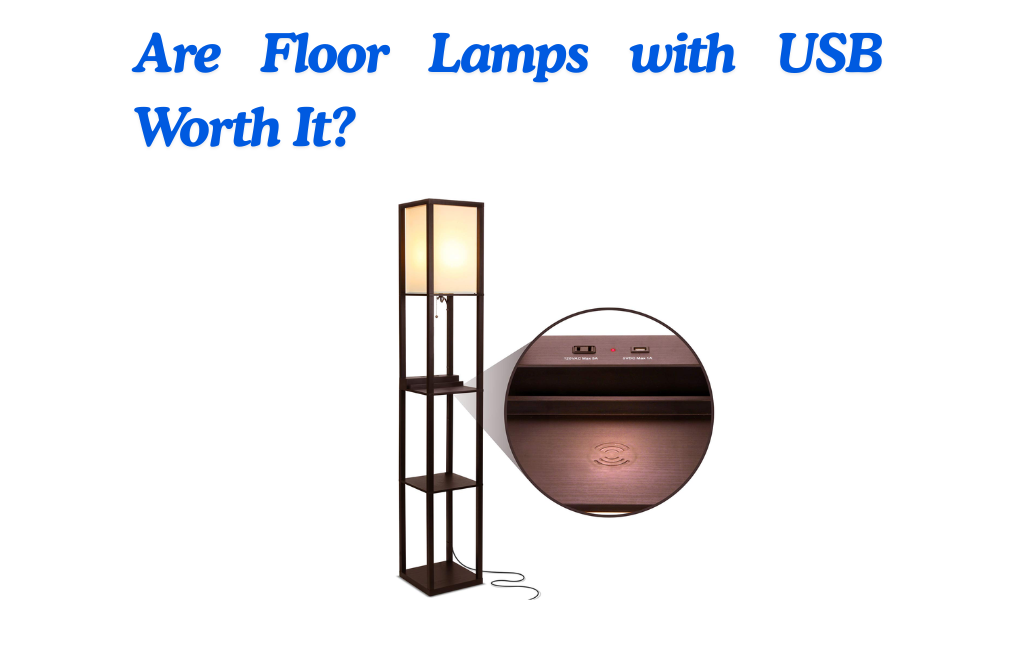Indoor Lights

Are Floor Lamps with USB Worth It? - 5 Disadvantages Explained
There’s no denying it — convenience has become the heartbeat of modern living. We want things that charge faster, connect seamlessly, and fit neatly into our ever-busier lives. So it’s no surprise that floor lamps with built-in USB ports are suddenly everywhere.
They promise practicality: “Imagine charging your phone right next to your reading chair!” Sounds perfect… until you actually live with one.
As someone who’s spent years testing, designing, and recommending lighting, I can tell you: the USB trend is not always the smart choice it appears to be. Let’s look beneath the marketing gloss and uncover the real picture — the hidden disadvantages you might not have considered.
Low Charging Power: Not Suitable for Modern Devices
Here’s the first truth bomb: most USB floor lamps are underpowered. Typically, these ports deliver just 5V/1A — the same output as a budget travel charger from ten years ago.
Sure, your phone might charge, eventually. But tablets, smartwatches, and newer smartphones (which crave fast charging) will barely crawl upward in percentage. It’s like trying to fill a swimming pool with a straw.
If your lamp is meant for lighting, it should shine. If it’s meant for charging, it should charge. Trying to do both often means doing neither particularly well.
(Our philosophy? Keep your lamp a lighting expert — not an amateur electrician.)
USB Ports Can Break Easily
Let’s be honest: USB ports weren’t built for furniture. They’re delicate, they wiggle, and after enough insertions, they loosen.
When a port breaks on your lamp, it’s not just an inconvenience — it’s a design flaw that’s hard to ignore. The entire piece suddenly looks… tired. Sometimes, it even means the lamp needs servicing or replacement.
That’s a high cost for a feature you might not even use every day.
By contrast, a clean, port-free design eliminates that weak link entirely. No fragile components, no wear and tear — just lasting simplicity.
Lighting should age gracefully, not electrically.
Safety Risks You Might Not Expect
Few buyers realize this, but adding a USB module to a lamp introduces an entirely new electrical circuit — and not all manufacturers are qualified to do it right.
Low-quality USB components can overheat, short-circuit, or simply degrade faster than the main power system. It’s like adding an unstable organ to an otherwise healthy body.
Now imagine that lamp plugged in overnight, near your sofa, surrounded by fabrics. Not exactly comforting, right?
As lighting designers, we always say: a lamp should make you feel safe, not cautious. Our lights focus on clean, certified circuits that do one job — and do it perfectly: illuminating your space safely and beautifully.
Bulky Design and Less Aesthetic Appeal
Let’s talk style. USB modules take up space — real, physical space. To fit them in, designers often thicken the lamp base or crowd the pole with extra cutouts and wiring.
What you end up with is something that feels… over-engineered. A lamp that looks more like a gadget than a piece of décor.
But lighting should blend into your interior — it should breathe with the room, not compete for attention. The most timeless designs are often the simplest ones: pure lines, elegant silhouettes, and a light that feels intentional, not interrupted.
(And yes, removing that clunky USB module helps achieve exactly that.)
Added Cost Without Real Value
This one might surprise you: USB floor lamps often cost more than standard ones, even though the charging module adds very little practical value.
Think about it — you already have outlets, extension cords, wireless chargers… even your sofa might have a USB port. Do you really need one on your lamp too?
In most cases, the USB feature is just a marketing hook, not a meaningful improvement.
When you strip it away, you can invest in what truly matters: better materials, higher color rendering (CRI), smoother dimming, and longer-lasting components.
That’s where real value lives — in the light itself.
So, What’s the Better Alternative?
If you love the idea of convenience, you’re not wrong — but consider a smarter form of it. Choose a lamp that’s simple, safe, and beautifully made.
A lamp that illuminates your evenings with warmth instead of worry. A lamp that stands gracefully, without unnecessary extras. A lamp that will still look (and work) just as good five years from now.
That’s why our collection focuses on minimalist floor lamps — clean, durable, and built to last. Every curve, switch, and joint is designed for everyday comfort and timeless style.
Because light should serve you — not distract you.
Explore our collection of minimalist floor lamps and discover how simplicity can feel so much smarter.
FAQs
Are floor lamps with USB ports safe?
Some are, but low-quality models can overheat or short-circuit over time. Always check electrical certifications before buying.
Can I charge my iPhone or tablet with a USB floor lamp?
Most offer only 5V/1A output — far below modern fast-charging standards. You’ll be waiting a while.
What’s a better alternative to USB lamps?
A well-made, minimalist floor lamp that focuses on lighting performance, materials, and safety. Pair it with a proper fast charger for the best of both worlds.
Final Thoughts
In lighting — as in life — simplicity usually wins. The glow of a well-crafted lamp is its own kind of technology: reliable, elegant, quietly brilliant.
So before you buy that “USB-equipped” floor lamp, pause and ask:
Do I need more ports, or do I just need better light?

